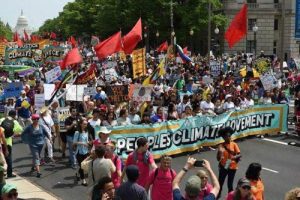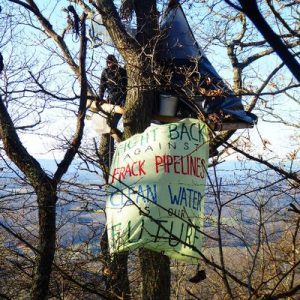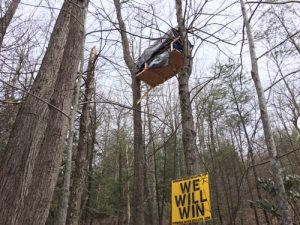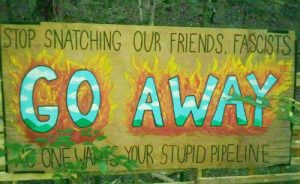How Would You Resist a Natural Gas Pipeline in Your Backyard?
 I grew up in the Blue Ridge Mountains. Southwest Virginia in Montgomery County. I grew up playing in the forests of Brush Mountain, and later hiking the trails of Peters Mountain. I grew up to the smell of earth and woke to the sound of birds. Then, the place where I grew up became a neighbor to the proposed crossing of the Mountain Valley Pipeline (MVP).
I grew up in the Blue Ridge Mountains. Southwest Virginia in Montgomery County. I grew up playing in the forests of Brush Mountain, and later hiking the trails of Peters Mountain. I grew up to the smell of earth and woke to the sound of birds. Then, the place where I grew up became a neighbor to the proposed crossing of the Mountain Valley Pipeline (MVP).
I remember seeing the first news pop up. By this time, I had seen the resistance to the Keystone Pipeline. I spent years learning about climate change, and I knew what this meant. I shared the first Facebook post with a caption, “We will fight this.” I didn’t comprehend the way this project and its sister, the Atlantic Coast Pipeline, would rock the lives of so many; or the way it would steal the peace of mind and wellbeing of our communities.
 So, I began fighting it the way I was told. I wrote and helped others write letters to politicians. Of course, none of them were answered or acknowledged, nor did they seem to have any influence. Terry McAuliffe, Ralph Northam, Mark Herring, Tim Kaine, Mark Warner, etc. I submitted comments to the Federal Energy Regulatory Commission (FERC). The process was narrow, meetings were infrequent, did not take place in the communities affected, and attendees were granted only three-minute time slots to submit concerns. We went to hearings with the Department of Environmental Quality, though we quickly discovered that its director, David Paylor, actively colluded with industry, taking gifts from the company, including a trip to the Grand Master’s Open Golf Tournament. I worked with community members, received the privilege of getting to know them and their lives and watched them bare their souls to blank-faced board members. The process was not, nor was it ever, meant to be a means to challenge the pipeline.
So, I began fighting it the way I was told. I wrote and helped others write letters to politicians. Of course, none of them were answered or acknowledged, nor did they seem to have any influence. Terry McAuliffe, Ralph Northam, Mark Herring, Tim Kaine, Mark Warner, etc. I submitted comments to the Federal Energy Regulatory Commission (FERC). The process was narrow, meetings were infrequent, did not take place in the communities affected, and attendees were granted only three-minute time slots to submit concerns. We went to hearings with the Department of Environmental Quality, though we quickly discovered that its director, David Paylor, actively colluded with industry, taking gifts from the company, including a trip to the Grand Master’s Open Golf Tournament. I worked with community members, received the privilege of getting to know them and their lives and watched them bare their souls to blank-faced board members. The process was not, nor was it ever, meant to be a means to challenge the pipeline.
We watched the rules confused, changed, and restricted. We watched the process compartmentalized and dehumanized into checkboxes. We watched pipeline workers, security, and state police engage in intimidation tactics against elderly and young folks alike at meetings, on folks’ own land while surveying, and sometimes late at night, tailgating drivers whose cars sported recognizable bumper stickers. Eventually, we watched the FERC do what it has done with every pipeline that has come to its desk — even as accidents, spills and explosions have become more commonplace (pipelines now leak twice a week) — they gave their final rubber stamp and approved the MVP to begin construction.  The pipeline now truly had the backing of the state.
The pipeline now truly had the backing of the state.
Since that time the Fourth Circuit Court of Appeals has vacated two federal decisions to build through the Jefferson National Forest, as well as denied access to cross the Appalachian Trail. Likewise, it vacated the Corp of Engineers stream-crossing authorization in West Virginia and suspended it in Virginia. These are prerequisites for the FERC authorization. Yet, work has continued. Though many of us now see this as obvious, we thought that in some way the state might protect us, do its job, and stop construction when the MVP was proven to be unsafe, to have insufficient protections, and needed lies to be approved. Nevertheless, something else has grown since the approval of the MVP. Resistance. A resistance that no longer accepts a clearly tainted process, that does not see unjust laws as legitimate, and does not respect the authority of those who do not value the humanity of the people they represent.
Just as those living along the route of the pipeline expected, many people have lost everything. Family businesses and livelihoods — with some, like the residents of Four Corners Farm, forced to move away. Peace of mind — like those on Bent Mountain who spoke about the depression and grief that has come with the felling of their trees and the desecration of their sense of place. Water — like the streams of residents in Giles County that have dried up or become backed up with sediment. But resistance has also been a force of healing. It stirs the imagination, letting us us see through the facade of order, to realize that the power behind this pipeline only exists if people continue to go along with it. We see what just a few people can do as we watch the MVP run a billion dollars over budget, over a year behind schedule, and without a clear path to completion for lack of key permits. That has been the power of direct action led by a small group of folks willing to do something different.
Early in February 2018, the news broke that two trees on Peters Mountain had become the new home to anonymous individuals along the route of the Mountain Valley Pipeline. Right along the border of West Virginia and Virginia and along the route of the Appalachian Trail, the aerial blockade began a new phase of resistance. As many expected, the Appalachian Trail was one of the first locations where the MVP attempted to cut down trees and begin construction, likely knowing that it was the most precarious of their permits. The Peters Mountain tree-sits not only began a new stage of direct action, they caused the first massive delay that allowed the legal challenges to the MVP to catch up. To this day the pipeline has not crossed the Appalachian Trail. Tactics such as concealing identities allowed for legal ambiguity that also stalled the process as the MVP attempted to file injunctions against John/Jane Does, ultimately failing in its first injunction against tree sitters and their supporters. Furthermore, the tree-sits galvanized and invigorated resistance in people of two states who had seemed without hope after procedural avenues ran out. Folks began hiking supplies up and down the mountain, holding rallies and fundraisers in support of the tree sitters, and — most importantly — meeting one another and starting to imagine what else was possible.
I was out monitoring work and tree-cutting crews when I saw a Facebook post, “the Bent Mountain tree sit has begun!” A mother and daughter, Red and Minor, had climbed into trees to protect their land in Roanoke County. They made the decision after seeing Peters Mountain. “Stand With Red” became a phrase that received international media coverage on a scale the pipeline fight had yet to see. For a month, the 61-year-old woman and her daughter remained in two trees along the route, blocking construction and creating a swell of unity from communities in Bent Mountain and Roanoke County, Franklin County, Montgomery County, and beyond.
Around the same time in Giles County, along the access road leading to the mountain where the Peters Mountain tree sitters maintained their blockade, the Monopod, a 40-foot pole was erected with a platform on top that supported a sitting protester. From the Monopod hung a banner declaring “The Fire is Catching!” Not long after, another set of tree-sits were revealed in Franklin County, blocking the MVP access to a family farm. Within less than two months following the erection of the aerial blockades on Peters Mountain, four additional aerial blockades stood in separate counties in opposition to the Mountain Valley Pipeline. The fire had spread, and new life was breathed into the resistance — a resistance that looked and felt different, that recognized that the MVP fight was about more than one stretch of trees, or even the one pipeline. It was opposition to all pipelines. It was opposition to the entire fossil fuel infrastructure. It was opposition to a system that has disenfranchised communities and exploited land and people, a system that has built on a legacy of colonial interests that stole from poor, working class, indigenous, brown and black people for the sake of a very small wealthy few.
No single battle could beat the pipeline. Even as the public united against the MVP, even as its permits were pulled, its budget skyrocketed, its CEO forced to resign (twice), and it was caught violating safety and erosion standards over 300 times — it continued. Eventually, aerial blockades came down and trees were cut. But the resistance showed that its tactics could also evolve. On June 28, 2018, I drove up Brush Mountain, minutes away from the house where I was raised, passing the scars already gouged by the pipeline. I drove up the mountain where I played during my youth, because at the top my friend and comrade had locked herself to the top of an excavator blocking work for 14 hours.
She became the first to engage in a lockdown action in Montgomery County. A few months later two more tree-sits went up in Montgomery County, blockading some of the last trees remaining along the route of the MVP. These tree-sits would become the longest aerial blockades in the history of the East Coast, continuing to stand to this day (October 29th at the time of writing – 420 days and counting). The Yellow Finch blockade in Elliston, Virginia stood strong over a year of ongoing resistance and more lockdowns in West Virginia, some of which resulted in trumped up felony “threat of terrorism” charges.
 It was through visiting this camp that I continued to pass the land that had shaped me, continued to see the scars, and continued to reflect on the year and a half of inspiring, innovative, and beautiful resistance. To see people risk everything out of acknowledgement that this pipeline was putting everything at risk. I grew up in these lands. I am fortunate to have people who support me and know who I am. I had seen what some people could do. Just people using their skills and their relationships to do everything they could to sculpt the world in a way that did not include fracked gas pipelines. People who understood that if they wanted something different, they had to make it so. What if more people did this? Years ago, I was part of the massive media stunt that was the People’s Climate March. Hundreds of thousands marched on permitted streets holding colorful banners demanding climate justice. What if all those people did something more, and decided to intervene directly and make their ideal world so? If I wanted that to happen, I had to make it so and be an example.
It was through visiting this camp that I continued to pass the land that had shaped me, continued to see the scars, and continued to reflect on the year and a half of inspiring, innovative, and beautiful resistance. To see people risk everything out of acknowledgement that this pipeline was putting everything at risk. I grew up in these lands. I am fortunate to have people who support me and know who I am. I had seen what some people could do. Just people using their skills and their relationships to do everything they could to sculpt the world in a way that did not include fracked gas pipelines. People who understood that if they wanted something different, they had to make it so. What if more people did this? Years ago, I was part of the massive media stunt that was the People’s Climate March. Hundreds of thousands marched on permitted streets holding colorful banners demanding climate justice. What if all those people did something more, and decided to intervene directly and make their ideal world so? If I wanted that to happen, I had to make it so and be an example.
My action was nothing without those who precipitated it. It was one blockade in a long string. But for me, and for how I understood the means of making change directly, it was huge. In that moment, I felt aligned with that understanding which others had felt at some point. I felt the deep support of those willing to guide me. It was early morning June 28th, 2019, a year after my dear friend locked down on my home mountain, that I climbed my excavator not far away. I remember the moment of locking in, after days of anxiety, having decided what I must do. I remember seeing the stars with the slight glint of sunlight peering over the mountain. It was a moment of profound relief, because I knew for the next little while there were no more decisions to make. I was where I needed to be with my profound belief that this pipeline must not continue. They were set to work right here today. But today, that wouldn’t happen and that was the power I held.
“These actions are not just about this stretch of pipe, this stand of trees. These actions are a defiance. Defiance of a world in which men with guns protect men with chainsaws in the name of destroying memories, homes, and lives. Defiance of the idea that progress is measured by the thickness of the wallets of a heartless few, at the expense of land they never learned, explored, loved, or even set foot upon. Defiance of our erasure, of a thousand stories cut short by an excavator that does not understand life with balance, only destruction and domination. Defiance of a multibillion-dollar disaster backed by a state born from genocide and violence. Defiance of a project that has become a studied master of systematic decimation of land, species, and all deemed its economic opposition.
This pipeline is a leaf sprouting from the branches of fossil fuel companies like EQT, from the trunk of a country cultivated by exploitation, colonization, and imperialism for profit, rooted in capitalism, extraction, and white supremacy. This leaf will flourish if the branch is ignored, it will multiply if the trunk is left standing, it will spread if the roots are not uprooted. There has always been injustice, and there has always been law-breaking, leader-defying resistance in order to sculpt the world where we currently live.
Now we fear a future of climate catastrophe. But it is not the future that I want us to think about. It is now. What will you do now? This action alone won’t stop the pipeline, but just like the spark that ignited me, this action might ignite something more. A new world is not rooted in what feels possible. It doesn’t come with a reliable timeline. It can’t be a hobby, a block within your school or work schedule, or only what makes you feel comfortable.
Can you think of anything more beautiful than standing alongside those you love, staring hopelessness, isolation, and collapse in the face? When it meets your gaze and hisses, ‘Sit down, shut up, give up,’ you smile, meet its gaze, and say, ‘No.’
Truly, what could be more worth fighting for?”
This was the statement I gave. Since then, there have been multiple other actions and lockdowns. The fire continues to spread. The MVP continues to work and continues to suffer let downs. Two indigenous women who fought as water protectors at Standing Rock were among those who locked down against the MVP in West Virginia. Most recently, a 72-year-old raging granny locked down and stopped work for five hours. Across the country, strikes and actions expand with solidarity messages across banners for the MVP and other pipeline fights.
I continue to remember the moments that shaped me into a pipeline fighter and a water protector. It was moments when I came face to face with the injustice that was taking place. Moments when I saw the devastation of pipeline construction with the clear-cutting and mudbanks where people’s memories were once built. The callousness of pipeline workers as they tailed old folks driving down their mountain or sent tree cutters up a tree to cut portions off — even while it housed a human. Met the people whose passions sparked my own and made me imagine and feel fierce. By taking action, I hope to be that spark for others, but I also plan to directly fan that flame in person. It is my goal and ongoing plan to be a link to those whose fires are just beginning to catch. As the resistance moves forward new leaders will emerge, many through the guidance and the spark of past leaders. I want to show them the injustice they face, share the experiences and trauma I have experienced in this battle and those adjacent to it. Then, I want to give them all the tools I know, and the connection with others who have even more, so that they can know how to fight. So that they can have the same support I did and be able to create the world they want as effectively, and safely as possible.
This pipeline alone would double our state’s climate emissions. We are at a point where that is simply not an option. Meanwhile, over a dozen other projects across our country carry the same danger that would slam the door on a livable climate. We have no time for the procedure to right itself, for the political wheel to hasten, or for the broken economic system to miraculously become something that cares for human welfare and survival. We have to believe that our comrades all over are fighting every struggle like the Mountain Valley Pipeline with as much fervor and fire as we are. To not act differently and imaginatively is not an option. To quote a loving friend who spent some time at the top of a white pine, “We may lose yes, but we lose so much more if we fail to show up in the first place.”
 — Michael James-Deramo, Rachel Carson Council Fellow. Michael James-Deramo graduated from Virginia Commonwealth University and is a co-founder of the Virginia Student Environmental Coalition. [email protected]
— Michael James-Deramo, Rachel Carson Council Fellow. Michael James-Deramo graduated from Virginia Commonwealth University and is a co-founder of the Virginia Student Environmental Coalition. [email protected]










